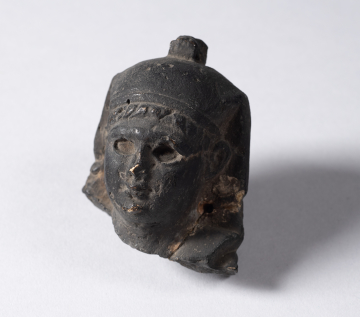Explore Collections


You are here:
CollectionsOnline
/
Head of the Emperor Claudius (41-54 AD) in Egyptian dress
Browse
SM L114. ©Sir John Soane's Museum, London. Photo: Justin Piperger
Head of the Emperor Claudius (41-54 AD) in Egyptian dress
41-54 AD
Claudian
Claudian
Formerly thought to be Parian marble; following analysis in 2024 most likely to be limestone (coarse-grained limestone from Northern Egypt) or, alternatively, sandstone. Interestingly, neither of these materials are common for royal statues in the Pharaonic period.
Height: 8.5cm
Width (at mouth level): 7cm, maximum
Width (at mouth level): 7cm, maximum
Museum number: L114
Not on display
Curatorial note
The head of a Julio-Claudian prince, probably the Emperor Claudius I in an Egyptian-type headcloth, arranged to show a row of curly locks above the forehead and falling down on the neck behind the ears.1 The uncertain object on the top of headcloth is partially broken away and may have been the royal Uraeus, although this attachment was not common to the headdress in the purer periods of Egyptian art. The eyes are now hollow sockets and were probably inlaid in glass or a semi-precious material; the damage about their edges indicates they may have been removed hurriedly and with force, perhaps at the time when the neck was shattered.
In spite of the rough, vigorous and almost impressionistic work, the peculiar features of the fourth Roman Emperor appear fairly certainly defined; short face on a long neck with Adam's apple, curved nose, pursed lips, and small chin, and curled ears. The damage about the jaws and chin does not completely obliterate the characteristic modelling, and the head has a provincial force and charm. Probably from a cult or household shrine statue of the Emperor and most likely from Egypt where such honours were paid to the Emperor as the successor of the Pharaohs and the Ptolmaic house.
The technique of inlaid and coloured eyes (which undoubtedly gave life to this statuette) used in Imperial portraiture from Egypt, recalls the new celebrated bust of the younger Augustus in bronze from the excavations at Meroe in Upper Egypt (British Museum no. 1911,0901.1; Marbles and Bronzes, pl.49).
This is an example of the kind of small item that might have been either out on a table or in a drawer in Sir John Soane's day.
1 Vermeule's orignal typescript catalogue of Soane Museum Antiquities includes a pencil note here: 'Compare the parallels, W. Needler, Berytus, 1949, plate XXV, 3, 4, pp.133ff.'.
In spite of the rough, vigorous and almost impressionistic work, the peculiar features of the fourth Roman Emperor appear fairly certainly defined; short face on a long neck with Adam's apple, curved nose, pursed lips, and small chin, and curled ears. The damage about the jaws and chin does not completely obliterate the characteristic modelling, and the head has a provincial force and charm. Probably from a cult or household shrine statue of the Emperor and most likely from Egypt where such honours were paid to the Emperor as the successor of the Pharaohs and the Ptolmaic house.
The technique of inlaid and coloured eyes (which undoubtedly gave life to this statuette) used in Imperial portraiture from Egypt, recalls the new celebrated bust of the younger Augustus in bronze from the excavations at Meroe in Upper Egypt (British Museum no. 1911,0901.1; Marbles and Bronzes, pl.49).
This is an example of the kind of small item that might have been either out on a table or in a drawer in Sir John Soane's day.
1 Vermeule's orignal typescript catalogue of Soane Museum Antiquities includes a pencil note here: 'Compare the parallels, W. Needler, Berytus, 1949, plate XXV, 3, 4, pp.133ff.'.
Unrecorded.
Literature
C. Vermeule, Roman Imperial Art in Greece and Asia Minor, Cambridge (Mass.) 1968, pp. 388, 414.
A-K Massner, 'Agyptisierende Bildnisse des Kaisers Claudis', Antike Kunst 29, 1986, I, pp. 63-64, 67, pl. 10, fig. 1.
P.E. Stanwick, Egyptian Royal Sculptures of the Ptolemaic Period, New York University, Institute of Fine Arts, 1999, pp. 518-19 (with further bibliographical notes)
Nicola Barbagli, Faraoni Romani: rappresentazioni del potere imperiale in Egitto da Augusto a Domiziano, PhD. Dissertation, Scuola Normale Superiore, Pisa 2022. For this Soane head see pp.253-254, and plate XXXII. Dissertation publicly available online https://hdl.handle.net/11384/109540
A-K Massner, 'Agyptisierende Bildnisse des Kaisers Claudis', Antike Kunst 29, 1986, I, pp. 63-64, 67, pl. 10, fig. 1.
P.E. Stanwick, Egyptian Royal Sculptures of the Ptolemaic Period, New York University, Institute of Fine Arts, 1999, pp. 518-19 (with further bibliographical notes)
Nicola Barbagli, Faraoni Romani: rappresentazioni del potere imperiale in Egitto da Augusto a Domiziano, PhD. Dissertation, Scuola Normale Superiore, Pisa 2022. For this Soane head see pp.253-254, and plate XXXII. Dissertation publicly available online https://hdl.handle.net/11384/109540
Soane collections online is being continually updated. If you wish to find out more or if you have any further information about this object please contact us: worksofart@soane.org.uk















